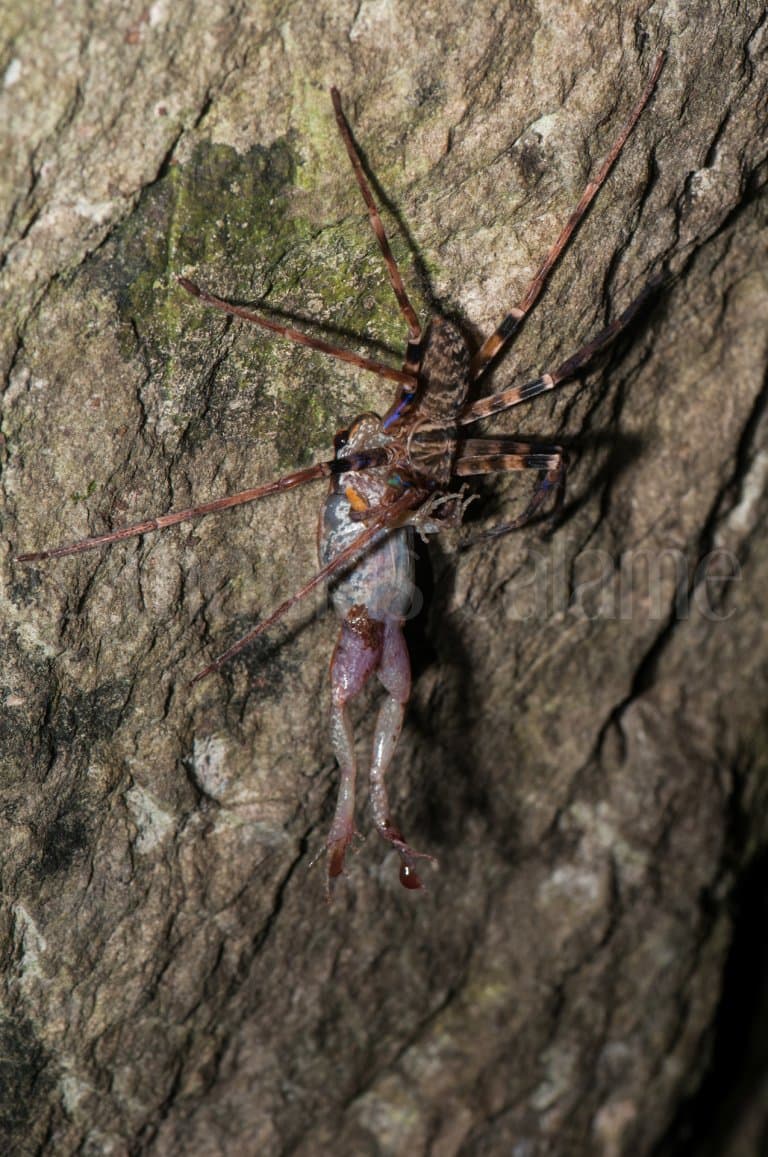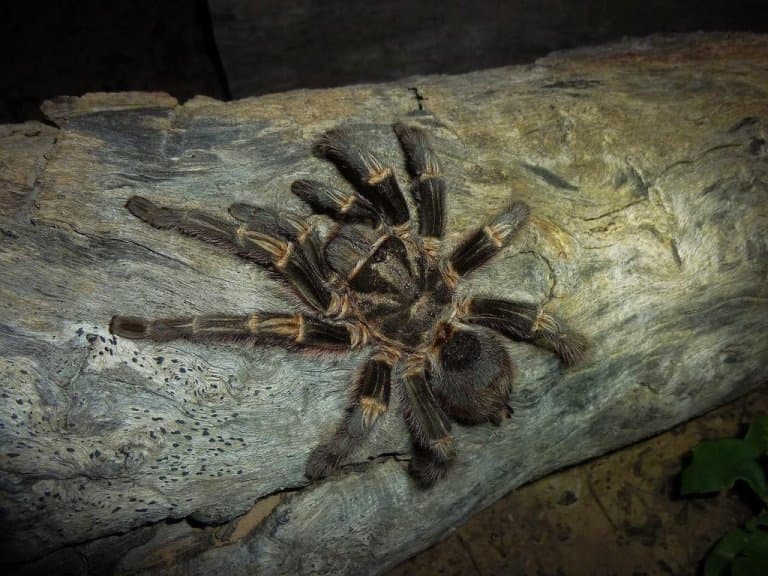Animal Facts: World Biggest Spiders
The Biggest Spiders In The World
Spiders have historically been feared and mistrusted by humans, with the assumption that they are hidden nearby, waiting to bite an unsuspecting victim. In truth, spiders are shy creatures, and very rarely show any aggression towards people unless provoked.
In nature, spiders come in a variety of sizes, shapes and are found on every continent across the world expect for Antarctica. They all have eight legs, fangs and can produce silk, though not all make webs. Almost all species are carnivorous predators, however a few jumping spiders also feed on dead insects and even some plants.
The the biggest spiders in the world often invoke the most irrational fear amongst us.
 Giant Huntsman Spider eating a frog (Micryletta inornata). (https://www.inaturalist.org/photos/134409).
Giant Huntsman Spider eating a frog (Micryletta inornata). (https://www.inaturalist.org/photos/134409).
There are well over 45,000 known species of spider across the globe and possibly many more yet to be discovered. For the purposes of this piece, we will focus on the spiders that have the biggest leg-span, rather than which are heaviest.
We’ve used the most reliable and verified sources and studies to bring you the definitive ten biggest spiders in the world, and some surprising facts about these misunderstood animals.
10. Chaco Golden-Knee Tarantula (18cm)
One of the many tarantula species featured in this list, the Chaco golden-knee tarantula is a relatively colourful tarantula found in Paraguay and Argentina. So called for the golden patches on their leg joints, these spiders possess large fangs and are heavily built.
 https://www.inaturalist.org/photos/285718330
https://www.inaturalist.org/photos/285718330
Chaco golden-knees live in grasslands, burrowing under the soil to ambush insects and other invertebrates that cross their path.
With an average leg-span of around 18cm, these large spiders look fearsome, but are known to be rather docile when kept as pets. As with most tarantulas, males tend to have a bigger leg span while females have larger, heavier bodies.
9. Colombian Giant Redleg Tarantula (18cm)
The Colombian giant red legs is a huge tarantula found in the rainforest of Columbia and Brazil. Despite their large size, they are rather skittish and can move quickly across the forest floor.
 (https://www.inaturalist.org/photos/99265212)
(https://www.inaturalist.org/photos/99265212)
Like other tarantulas, when threatened, the Columbian giant red leg will flick off the hairs from its abdomen or legs at an attacker. The hairs, called urticating's hairs, are barbed and can cause immense irritation.
Columbian giant red legs also utilise another means of defence when cornered; they kick their attacker with barbed hind legs. With a leg span of 18cm or more, these kicks are usually enough to dissuade any potential predator.
8. King Baboon Spider (19cm)
Found in Central and Eastern Africa, the king baboon spider is truly a king. With a leg span of over 19cm, they are the biggest spider in all of Africa. These chunky spiders are known to be voracious predators and use their huge fangs to kill prey up to the size of lizards and bird chicks. They live in burrows in acacia scrubland and will readily attack any intruders.
These chunky spiders are known to be voracious predators and use their huge fangs to kill prey up to the size of lizards and bird chicks. They live in burrows in acacia scrubland and will readily attack any intruders.
Baboon spiders are so called due to their hairy appearance and legs that resemble baboon fingers.
They are part of a group of spiders called Old world tarantulas and are less hairy and have a far more painful bite than their North and South American cousins.
7. Hispaniolan Giant Tarantula (20cm)
This huge spider, with a leg span over 20cm is found in humid forests in Haiti and the Dominican Republic. They are mainly dark blue in colour but can also be found in a variety of shades, making them difficult to identify. The Hispaniolan tarantula is known to be an aggressive spider, however their bite is said to be similar to that of a bee sting.
The Hispaniolan tarantula is known to be an aggressive spider, however their bite is said to be similar to that of a bee sting.
That said, these nocturnal hunters inject venom into their prey and are capable of killing other spiders and insects the same size as themselves.
6. Poecilotheria Rajaei (20.5cm)
Endemic to Sri Lanka, this spider dubbed ‘the face-sized tarantula’ is an attractive, fast moving and venomous spider. Their common name is derived from the fact that this spider is roughly the size of a dinner plate or a large human face. Having only been discovered in 2009, little is known about this giant tarantula but some captured individuals have recorded a leg span of at least 20cm. Their bite is likely to be painful, but not life threatening to humans, however their venom is capable of killing animals as large as rodents.
Having only been discovered in 2009, little is known about this giant tarantula but some captured individuals have recorded a leg span of at least 20cm. Their bite is likely to be painful, but not life threatening to humans, however their venom is capable of killing animals as large as rodents.
Despite a fearsome appearance, Poecilotheria rajaei is intricately patterned with bright yellow banding on its legs and a pink stripe along the abdomen.
As with most spiders, they are generally shy unless disturbed or threatened.
5. Brazilian Giant Tawny Red Tarantula (24cm)
As well as being one of the largest spiders in the world, the Brazilian giant tawny red tarantula is also said to be one of the longest-lived spiders, possibly living to 20 years of age.
 (https://www.inaturalist.org/photos/286273226)
(https://www.inaturalist.org/photos/286273226)
They have a massive leg span of around 24cm and huge fangs, though their venom is not lethal to humans.
This spider is found throughout several countries in South America and as the name suggests, they are almost entirely tawny red in colour.
Their main prey are insects and reptiles such as lizards that inhabit the same drier regions in the area.
4. Brazilian Bird-Eating Tarantula (27cm)
Also called the Salmon pink bird eater, this massive tarantula is a speedy, nocturnal predator found in Brazilian forests. They have pink hair on their abdomen and legs and have a leg span of around 27cm. Although they mostly feed on insects, this tarantula will actively hunt small mammals and as the name suggests, they will also catch and eat unsuspecting adult birds or their chicks.
Although they mostly feed on insects, this tarantula will actively hunt small mammals and as the name suggests, they will also catch and eat unsuspecting adult birds or their chicks.
They spend most of their time on the forest floor and rely on speed and fast-acting venom to catch their prey.
3. Goliath Pinkfoot Tarantula (28cm)
Living in burrows in the forests of Brazil and Venezuela, the pinkfoot goliath is a true giant amongst spiders. Their legs have pink coloured feet and their leg span can measure over 28cm.
 (https://www.inaturalist.org/photos/294471844)
(https://www.inaturalist.org/photos/294471844)
They are known to be particularly defensive tarantulas, capable of delivering a painful bite.
Like other members of the genus, they hunt large prey as well as insects and are capable of killing birds up to the size of a chicken. Luckily their venom is only mildly irritating to humans and they are in fact a desirable species amongst experienced tarantula hobbyists.
2. Goliath Bird-Eating Tarantula (29cm)
Similar in many ways to the Goliath pinkfoot tarantula, the goliath bird eater has a leg span of around 29cm and is the second largest spider in the world, and heaviest by mass.
They live in the wet, humid forests of South America and as their name suggests, will catch and eat birds if the opportunity arises. However, they mostly feed on insects and smaller vertebrates, dragging their prey back to the burrow to feed.
As with other Theraphosa species, they can produce a warning sound by rubbing the hairs on their legs and other parts together; an act called stridulation. If the warning fails, they will proceed to flick irritant hairs at their attacker.
1. Giant Huntsman Spider (30cm)
It is surprising that the world’s largest spider, by leg span, was only discovered in 2001. The giant huntsman is only found in a small cave system in Laos, South East Asia.
 (https://www.flickr.com/photos/insecta62/2086564793/)
(https://www.flickr.com/photos/insecta62/2086564793/)
The leg span of the largest individual measured was around 30cm and it is likely larger specimens are still to be recorded. The giant huntsman lives in caves and hunts insects and other spiders within this habitat. They will also lurk around cave entrances and catch birds, rodents, bats and even snakes if they come across them.
The giant huntsman spider has been observed living in large groups, seemingly tolerating one another. However when food is in short supply, this species may resort to hunting and eating other members of the same species.
Conclusion
That completes our list of the largest spiders on the planet.
With smaller creatures, especially invertebrates such as spiders, defining and ordering species in size can be a tricky task. This is due to the fact that often these animals are less researched than larger species, and therefore far less is known about them.
Most species in this list are members of the tarantula family and it is no surprise that these species are often the largest. As they don’t spin webs to help catch prey, it is essential that these spiders are fast, strong and have potent venom to catch larger prey items. This in turn means that they tend to have to eat less often, especially if they are able to out-muscle and paralyse prey as large as a bird.
Much like the giant huntsman spider, it is likely that there are many, many more unknown species of spider yet to be discovered. There may even be a species larger than the giant huntsman, hiding in an inaccessible or rarely visited area of the world.
Fact Sources & References
- “Spiders“, National Geographic.
- “Chaco Golden Knee Tarantula (Grammostola pulchripes) Care Sheet“, The Tarantula Collective.
- “The spider king of Africa“, Mongabay Kids.
- Sky (2013), “Tarantula The Size Of A Human Face Discovered“, Sky News.
- Carolina Horta et al (2015), “The Venom from Lasiodora sp.: A Mygalomorph Brazilian Spider“, Springer Science.
- James Cutmore (2023), “Top 10: Biggest spiders in the world“, BBC Science Focus.















































